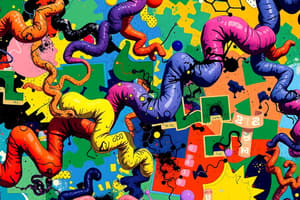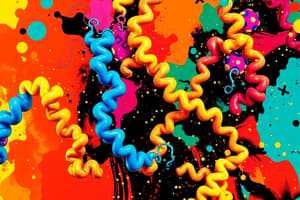Podcast
Questions and Answers
What happens to the alpha-helix and beta sheets of a protein during denaturation?
What happens to the alpha-helix and beta sheets of a protein during denaturation?
- They remain unchanged.
- They are destroyed and uncoil into a disordered form. (correct)
- They become more stable.
- They double in number.
Which bond is least likely to be disrupted during a denaturation process?
Which bond is least likely to be disrupted during a denaturation process?
- Hydrogen bonding
- Disulfide bonds
- Salt bridges
- Peptide bonds (correct)
Which type of bonding interaction is involved in tertiary structure and can be disrupted by denaturation?
Which type of bonding interaction is involved in tertiary structure and can be disrupted by denaturation?
- Van der Waals forces
- Ionic bonds
- Hydrophobic interactions (correct)
- All of the above
What is a common result of the denaturation process?
What is a common result of the denaturation process?
What type of interactions are involved in the secondary structure of proteins that can be disturbed during denaturation?
What type of interactions are involved in the secondary structure of proteins that can be disturbed during denaturation?
What defines a zwitterion?
What defines a zwitterion?
At what pH relative to the pKa does a functional group become deprotonated?
At what pH relative to the pKa does a functional group become deprotonated?
Which of the following amino acids is classified as basic?
Which of the following amino acids is classified as basic?
What role do enzymes play in cellular functions?
What role do enzymes play in cellular functions?
Which level of protein structure is described as the most fundamental?
Which level of protein structure is described as the most fundamental?
Which statement accurately describes the nature of amino acids?
Which statement accurately describes the nature of amino acids?
What are oxytocin and vasopressin examples of?
What are oxytocin and vasopressin examples of?
What typically leads to protein denaturation?
What typically leads to protein denaturation?
What determines the unique structure and function of a protein?
What determines the unique structure and function of a protein?
How is a dipeptide formed?
How is a dipeptide formed?
What is the primary function of antibodies in the body?
What is the primary function of antibodies in the body?
Which of the following statements about protein structure is true?
Which of the following statements about protein structure is true?
Which process reverses the formation of a peptide bond?
Which process reverses the formation of a peptide bond?
What type of proteins are responsible for transmitting signals between different cells and tissues?
What type of proteins are responsible for transmitting signals between different cells and tissues?
Which property of amino acids affects their reactivity in different environments?
Which property of amino acids affects their reactivity in different environments?
Which function is NOT associated with proteins?
Which function is NOT associated with proteins?
Flashcards are hidden until you start studying
Study Notes
Proteins: Functions
- Proteins are large, complex molecules that perform various essential functions within the body.
- They are responsible for the construction, function, and control of tissues and organs.
- Proteins are composed of amino acids linked together in chains.
- The sequence of amino acids determines the unique three-dimensional structure and function of each protein.
Examples of Protein Functions
- Antibodies help protect the body by binding to foreign particles like viruses and bacteria.
- Example: Immunoglobulin G (IgG)
- Enzymes carry out chemical reactions within cells and assist in the formation of new molecules.
- Example: Phenylalanine hydroxylase
- Messenger Proteins transmit signals to coordinate biological processes between cells, tissues, and organs.
- Example: Growth hormone
- Structural Support Proteins provide structure and support for cells and facilitate movement.
- Example: Actin
- Transport/Storage Proteins bind and carry atoms and small molecules within cells and throughout the body.
- Example: Ferritin
Amino Acids: Properties
- Building Blocks of Proteins: Amino acids are the basic units that form proteins.
- Amine and Acid Groups: All amino acids have an amine group (NH2) and an acid group (COOH).
- Zwitterions: Amino acids exist in a neutral state called zwitterion, where they have both positive and negative charges.
- pH Sensitivity: The carboxyl and amino groups are sensitive to pH changes, affecting their protonation or deprotonation.
Amino Acid Subgroups
- Amino acids are categorized into four subgroups based on the properties of their side chains:
- Nonpolar (Hydrophobic) and Uncharged: These amino acids repel water.
- Examples: Alanine, Glycine, Isoleucine, Methionine, Phenylalanine, Proline, Tryptophan, Valine
- Polar (Hydrophilic) and Uncharged: These amino acids attract water.
- Examples: Asparagine, Cysteine, Glutamine, Serine, Threonine, Tyrosine
- Acidic (Polar and Charged): These amino acids have a negative charge.
- Examples: Aspartic acid, Glutamic acid
- Basic (Polar and Charged): These amino acids have a positive charge.
- Examples: Arginine, Histidine, Lysine
- Nonpolar (Hydrophobic) and Uncharged: These amino acids repel water.
Peptide Bonds
- Peptide bonds are formed between two amino acids through a dehydration reaction, releasing a water molecule.
- The resulting amide group is the peptide bond.
- Two amino acids linked together form a dipeptide.
- Peptide bonds have a flat, planar structure.
- Examples of peptides: Oxytocin and vasopressin, which are involved in social processes.
Levels of Protein Structure
- Fundamental Level: Primary structure refers to the sequence of amino acids in a protein chain.
- Folding and Shape: Secondary structure involves the folding of the polypeptide chain into specific arrangements like alpha-helices and beta-sheets, held together by hydrogen bonds.
- Three-Dimensional Arrangement: Tertiary structure describes the overall three-dimensional shape of a protein, stabilized by interactions between amino acid side chains, including hydrogen bonds, salt bridges, disulfide bonds, and hydrophobic interactions.
- Multiple Polypeptide Chains: Quaternary structure exists when multiple polypeptide chains (subunits) assemble to form a functional protein complex.
Protein Denaturation
- Denaturation disrupts the secondary and tertiary structures of a protein without breaking peptide bonds.
- Denaturation unfolds the protein, destroying its alpha-helices and beta-sheets.
- Factors that cause denaturation include heat, pH changes, and reducing agents.
- Denaturation typically results in protein precipitation or coagulation.
Studying That Suits You
Use AI to generate personalized quizzes and flashcards to suit your learning preferences.




